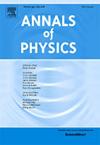Particle production induced by a Lorentzian non-commutative spacetime
IF 3
3区 物理与天体物理
Q2 PHYSICS, MULTIDISCIPLINARY
引用次数: 0
Abstract
In this paper, we examine particle production, evaporation, and greybody factors for a Lorentzian non-commutative black hole. We begin by analyzing particle creation for bosons, considering scalar perturbations to compute the Bogoliubov coefficients, which enable the determination of the Hawking temperature . Subsequently, we describe Hawking radiation as a tunneling process using the Painlevé–Gullstrand metric representation, allowing the evaluation of divergent integrals via the residue method. This approach yields the particle creation density for bosonic modes. Next, we extend the analysis to fermions, obtaining the corresponding particle creation density. The black hole evaporation is then examined through the Stefan–Boltzmann law, leading to an estimate of the black hole’s lifetime. In this context, we identify the presence of a remnant mass when the black hole reaches the final stage of its evaporation. Furthermore, we compute greybody factors for bosons, taking into account scalar, vector, and tensorial perturbations. Finally, we determine the greybody factors for fermions as well. Overall, compared to the Schwarzschild case (), the presence of the non-commutative parameter lowers the Hawking temperature and reduces the particle creation density for both bosons and fermions, causing the evaporation process to proceed more slowly. Additionally, decreases the magnitude of the greybody factors for bosons and fermions across all perturbations considered in this analysis.
由洛伦兹非交换时空诱导的粒子产生
在本文中,我们研究了洛伦兹非交换黑洞的粒子产生、蒸发和灰体因素。我们首先分析玻色子的粒子产生,考虑标量扰动来计算Bogoliubov系数,从而可以确定霍金温度TΘ。随后,我们使用painlev - gullstrand度量表示将霍金辐射描述为隧穿过程,允许通过残差法评估发散积分。这种方法产生玻色子模式的粒子产生密度。接下来,我们将分析扩展到费米子,得到相应的粒子产生密度。然后通过斯蒂芬-玻尔兹曼定律检查黑洞的蒸发,从而估计黑洞的寿命。在这种情况下,当黑洞达到蒸发的最后阶段时,我们确定了残余质量的存在。此外,我们计算灰体因子的玻色子,考虑标量,矢量和张量摄动。最后,我们也确定了费米子的灰体因子。总的来说,与史瓦西情况(Θ=0)相比,非对易参数Θ的存在降低了霍金温度,降低了玻色子和费米子的粒子产生密度,导致蒸发过程进行得更慢。此外,Θ在本分析中考虑的所有扰动中降低了玻色子和费米子的灰体因子的大小。
本文章由计算机程序翻译,如有差异,请以英文原文为准。
求助全文
约1分钟内获得全文
求助全文
来源期刊

Annals of Physics
物理-物理:综合
CiteScore
5.30
自引率
3.30%
发文量
211
审稿时长
47 days
期刊介绍:
Annals of Physics presents original work in all areas of basic theoretic physics research. Ideas are developed and fully explored, and thorough treatment is given to first principles and ultimate applications. Annals of Physics emphasizes clarity and intelligibility in the articles it publishes, thus making them as accessible as possible. Readers familiar with recent developments in the field are provided with sufficient detail and background to follow the arguments and understand their significance.
The Editors of the journal cover all fields of theoretical physics. Articles published in the journal are typically longer than 20 pages.
 求助内容:
求助内容: 应助结果提醒方式:
应助结果提醒方式:


